
The sweet potato or sweetpotato is a dicotyledonous plant that belongs to the bindweed or morning glory family, Convolvulaceae. Its large, starchy, sweet-tasting tuberous roots are used as a root vegetable. The young shoots and leaves are sometimes eaten as greens. Cultivars of the sweet potato have been bred to bear tubers with flesh and skin of various colors. Sweet potato is only distantly related to the common potato, both being in the order Solanales. Although darker sweet potatoes are often referred to as "yams" in parts of North America, the species is not a true yam, which are monocots in the order Dioscoreales.

Oxalis tuberosa is a perennial herbaceous plant that overwinters as underground stem tubers. These tubers are known as uqa in Quechua, oca in Spanish, yams in New Zealand and a number of other alternative names. The plant was brought into cultivation in the central and southern Andes for its tubers, which are used as a root vegetable. The plant is not known in the wild, but populations of wild Oxalis species that bear smaller tubers are known from four areas of the central Andean region. Oca was introduced to Europe in 1830 as a competitor to the potato, and to New Zealand as early as 1860.

Arracacia xanthorrhiza is a root vegetable that originates in the Andes, whose starchy taproot is a popular food item across South America where it is a major commercial crop.

Apios americana, sometimes called the American groundnut, potato bean, hopniss, Indian potato, hodoimo, America-hodoimo, cinnamon vine, or groundnut is a perennial vine that bears edible beans and large edible tubers.
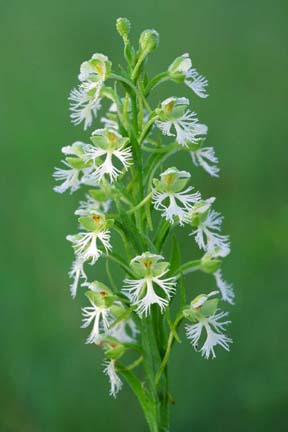
Platanthera leucophaea, commonly known as the prairie white fringed orchid or eastern prairie fringed orchid, is a rare species of orchid native to North America. It is a federally threatened species, protected since October 30, 1989 under the Endangered Species Act of 1973. In Canada, it has been listed endangered under Schedule 1 of the Species at Risk Act since 2005. In 2014, the International Union for Conservation of Nature assessed it as "least concern."

Yam is the common name for some plant species in the genus Dioscorea that form edible tubers.
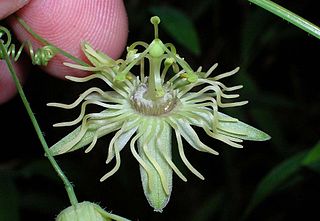
Passiflora lutea, commonly known as yellow passionflower, is a flowering perennial vine in the family Passifloraceae, native to the central and eastern United States. The vine has three-lobed leaves and small, yellowish-green, fringed flowers that appear in the summer, followed by green fruit that turn almost black at maturity. It grows in moist to wet habitats.

Dioscorea bulbifera is a species of true yam in the yam family, Dioscoreaceae. It is native to Africa, Asia and northern Australia. It is widely cultivated and has become naturalized in many regions.

Hemerocallis fulva, the orange day-lily, tawny daylily, corn lily, tiger daylily, fulvous daylily, ditch lily or Fourth of July lily, is a species of daylily native to Asia. It is very widely grown as an ornamental plant in temperate climates for its showy flowers and ease of cultivation. It is not a true lily in the genus Lilium, but gets its common name from the superficial similarity of its flowers to Lilium and from the fact that each flower lasts only one day.

Ipomoea pandurata, known as man of the earth, wild potato vine, manroot, wild sweet potato, and wild rhubarb, is a species of herbaceous perennial vine native to North America. It is a twining plant of woodland verges and rough places with heart-shaped leaves and funnel-shaped white flowers with a pinkish throat. The large tuberous roots can be roasted and eaten, or can be used to make a poultice or infusion. When uncooked, the roots have purgative properties.

Arctostaphylos myrtifolia is a rare species of manzanita known by the common name Ione manzanita. It is endemic to the Sierra Nevada foothills of California. It grows in the chaparral and woodland plant community on a distinctive acidic soil series, an oxisol of the Eocene-era Ione Formation, in western Amador and northern Calaveras counties. There are only eleven occurrences, of which three have not been recorded since 1976. This is a federally listed threatened species.
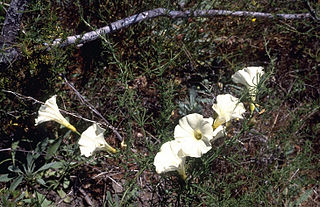
Calystegia stebbinsii is a rare species of morning glory known by the common name Stebbins' false bindweed. It is endemic to the Sierra Nevada foothills of California, where it is known from only two spots in El Dorado and Nevada Counties. It grows in unique habitat in chaparral on gabbro soils. It is a federally listed endangered species.

Enemion biternatum, commonly known as the false rue-anemone, is a spring ephemeral native to moist deciduous woodland in the eastern United States and extreme southern Ontario.
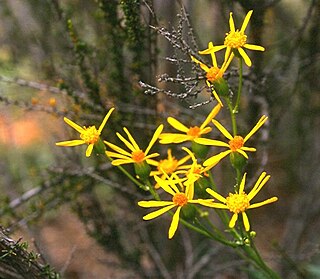
Packera layneae, known by the common name Layne's ragwort and Layne's butterweed, is a rare species of flowering plant in the aster family.

Bonamia grandiflora is a rare species of flowering plant in the morning glory family known by the common names Florida lady's nightcap, Florida bonamia, and scrub morning glory. It is endemic to Central Florida, where there are about 100 known populations remaining, many of which are within the bounds of the Ocala National Forest. The plant has declined in recent decades primarily due to the development of its habitat, which is being converted to urban zones and citrus groves. This is the primary reason that the plant was federally listed as a threatened species in 1987.

Clematis morefieldii is a rare species of flowering plant in the buttercup family known by the common names Morefield's leather flower and Huntsville vasevine.
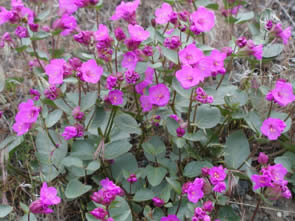
Mirabilis macfarlanei is a rare species of flowering plant in the four o'clock family known by the common name MacFarlane's four o'clock. It is native to Idaho and Oregon in the United States, where it is only known from three river canyons. It faces a number of threats and is federally listed as a threatened species of the United States.
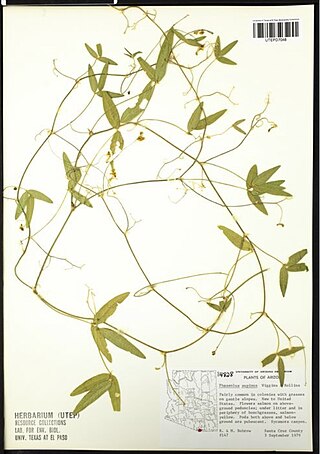
Macroptilium supinum is a species of flowering plant in the legume family known by the common name supine bean. It is native to Mexico, with its distribution extending north into the US state of Arizona.
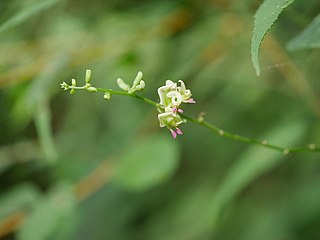
Apios fortunei, commonly known as hodo, hodoimo, groundnut, or potatobean, is a tuber-forming member of the Bean family. It is a native plant of Eastern China and Japan. It is one of three species in the genus Apios that are known to produce edible tubers, although it has generally been considered an emergency, or famine food or medicinal plant. A study done on the chemical composition of the tubers found that starch was the predominant carbohydrate, although smaller amounts of sucrose and glucose were found and almost no fructose was found. In the wild, Apios fortunei is often found near brooks. Apios fortunei is a perennial climbing vine. The leaves are pinnate with 3-7 leaflets and are ovate or lanceolate in shape, 3–7 cm long. Flowers have been variously described as whitish-green, light yellowish-green with a red purple edge on the wing petal, or sulphurous green with rosy wing petals. The flowers form pseudoracemes or terminal panicles, 6–26 cm long. The flowers are showy and have ornamental potential. Legume fruits are linear, 7–8 cm long and 5–6 mm wide.
Hibbertia priceana is a species of flowering plant in the family Dilleniaceae and is endemic to the south-west of Western Australia. It is a dwarf, usually compact shrub with erect, narrow elliptic leaves and bright yellow flowers with eleven stamens, nine in three groups of three, around three glabrous carpels.





















